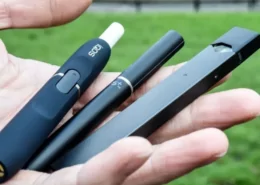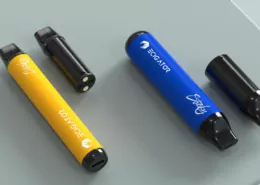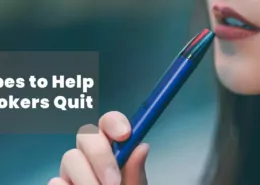Is Vaping Without Nicotine Safe?
In recent years, disposable vape pens have become increasingly popular among vapers. They offer a convenient and cost-effective way to enjoy vaping without the hassle of buying and refilling e-liquid or maintaining a device. Disposable vape pens are pre-filled with a specific flavor of e-liquid and are designed to be used until the e-liquid is gone. In this article, we’ll discuss the benefits of disposable vape pens and why they are becoming so popular.
E-cigarettes have been acknowledged by numerous medical experts as a significantly safer alternative to traditional tobacco products. However, smokers contemplating the switch frequently have unanswered questions. Interestingly, a common question we encounter is, “Is it safe to vape without nicotine?” This query is peculiar, as the usual debate revolves around the potential dangers of vaping with nicotine. The overstated risks of this mild substance are often used as justification for e-cigarette regulations and restrictions. In fact, some countries have enforced laws limiting nicotine content in vape liquids. For instance, the European Union caps nicotine concentration at 20mg/ml, and in Australia, purchasing e-liquids containing any nicotine at all is prohibited.
Understanding Nicotine Addiction and Vaping
It is crucial to recognize that nicotine addiction is a significant factor that drives people to smoke cigarettes. While nicotine itself may not be as harmful as once believed, its addictive properties cannot be dismissed. Vaping, especially with nicotine-containing e-liquids, can be an effective tool for those looking to quit smoking by providing a safer means of satisfying nicotine cravings.
The Role of Flavors in Vaping
One of the appealing aspects of vaping for many users is the wide variety of available flavors. While these flavors can enhance the vaping experience, it is essential to understand their potential impact on health. Some flavorings, particularly those that are diacetyl-based, have been linked to respiratory issues. As such, it is crucial to choose e-liquids from reputable sources and be aware of the ingredients used in their production.
The purported “dangers” of nicotine are predominantly unfounded. Although it can be poisonous in large quantities, the concentrations present in e-liquids—even the more potent ones outside the EU—do not pose any harm. Furthermore, nicotine is not inherently addictive when separated from other chemicals in tobacco smoke. Consequently, the alleged risks associated with vaping nicotine can be largely disregarded. So, why are people apprehensive about the safety of vaping without nicotine? This inquiry raises several legitimate concerns.
Read more: Everything You Need to Know About Nicotine
Vaping is A 95% Safer Alternative to Smoking
In 2015, Public Health England (PHE) announced that “vaping is at least 95% safer than smoking,” a statement they reiterated in 2018 while launching their “PHE’s Health Harms campaign.” Despite the widespread dissemination of the “95% safer” news, many vapers remain unaware of the scientific evidence that led PHE to make such a declaration. Let’s delve deeper into this topic.
The Rationale Behind Nicotine-Free Vaping
While most vapers use nicotine-containing e-liquids, some opt for nicotine-free alternatives. If you are vaping as a means to quit smoking or maintain abstinence from cigarettes, vaping without nicotine might not be the safest choice. The potential risk in this case is unrelated to vaping itself; rather, it stems from the possibility that an unsatisfying e-cigarette experience may drive you to purchase a pack of Marlboro. Before you know it, you could revert to smoking 20 cigarettes per day, a far more dangerous habit.
Some ex-smokers who have transitioned to vaping wish to eliminate nicotine entirely. This is a reasonable goal, but it is crucial to approach it with caution. Gradually reduce your nicotine intake, taking small steps and allowing yourself ample time to adjust. Most smokers who switch to vaping should begin with 24mg/ml e-liquids or 18mg/ml if limited by the EU’s restrictions.
After a few months, consider reducing your nicotine concentration to 12mg/ml, and after several more months, lower it to 6mg/ml. This process may appear slow, but keep in mind that as an ex-smoker, your body is accustomed to nicotine. Attempting to decrease your nicotine intake too quickly may result in failure and a potential return to smoking. Vaping high-nicotine e-liquids for the rest of your life is preferable to resuming smoking for even a month, as the nicotine content in e-cigarettes will not harm you.
Many ex-smokers are content to continue vaping, and if you are among them, there is no need to strive for nicotine elimination. For others who view vaping as a transitional stage, gradually reducing nicotine levels may be sensible. The key is to avoid rushing the process. Aim to reach zero nicotine within a year and then gradually taper off vaping altogether over the following six months or so.
Addressing the Non-Smoker Dilemma
What if you are not a smoker but wish to try vaping? Your motivation for doing so is essential. If you are tempted to smoke, trying a vape instead is a safer alternative. In this case, there is no reason to use nicotine if you have not already developed a dependence. However, if you are interested in vaping for recreational purposes or because it seems “cool,” it may be best to abstain altogether. The risks associated with e-cigarettes, although minimal, are not entirely non-existent. It is unwise to expose yourself to these risks merely for the sake of performing tricks or enhancing your image.
If there is a genuine issue with nicotine-free vaping, it likely affects smokers who reduce their nicotine intake too quickly. Such individuals may compensate for the lack of nicotine by vaping more frequently, ultimately increasing their overall liquid consumption. This could potentially raise health concerns related to flavorings rather than nicotine. In extreme cases, a person who has eliminated nicotine altogether may resort to vaping copious amounts of nicotine-free e-liquid in an attempt to satisfy their cravings. Consequently, they will be inhaling a significant quantity of flavorings. While it is theoretically possible that health effects related to vaping flavorings may emerge in 20 or 30 years, the likelihood of this occurring remains low.
Alternatives to Vaping for Smoking Cessation
While vaping can be a useful tool for those looking to quit smoking, it is not the only option available. Other smoking cessation methods, such as nicotine replacement therapies (gum, patches, lozenges), prescription medications, and behavioral therapy, can also be effective. It is crucial to explore different options and consult with a healthcare professional to determine the best approach for your individual needs.
Frequently Asked Questions
What are the health risks associated with vaping nicotine-free e-liquids?
While the risks are minimal, potential health concerns may arise from inhaling large amounts of flavorings in nicotine-free e-liquids.
How can I safely reduce my nicotine intake when vaping?
To safely reduce your nicotine intake while vaping, gradually decrease the concentration of nicotine in your e-liquids over time. Start with a higher concentration, such as 24mg/ml or 18mg/ml, and then reduce it to 12mg/ml after a few months. Continue this process until you reach 6mg/ml, and eventually zero nicotine. The key is to be patient and allow yourself time to adjust to the lower nicotine levels.
Is it safe for non-smokers to start vaping?
If a non-smoker is tempted to smoke, using a vape without nicotine is a safer alternative. However, for those interested in vaping for recreational purposes or to appear “cool,” it is advisable to abstain. Although the risks associated with vaping are minimal, they are not entirely non-existent, and it is unwise to expose oneself to these risks without a valid reason.
How long does it typically take to transition from nicotine-containing e-liquids to nicotine-free e-liquids?
The timeline for transitioning from nicotine-containing e-liquids to nicotine-free e-liquids varies depending on the individual. A reasonable goal for most people is to reach zero nicotine within a year of starting the transition. Once nicotine-free, you can consider gradually tapering off vaping over the following six months or so.
Are there any long-term health effects associated with vaping?
As of now, the long-term health effects of vaping are not well understood due to the relatively recent introduction of e-cigarettes. However, current evidence suggests that vaping is significantly less harmful than smoking traditional cigarettes. The potential health effects related to vaping flavorings may emerge in the future, but the likelihood of this occurring remains low.
In conclusion, while nicotine-free vaping can be a beneficial step for those looking to quit smoking or reduce their nicotine intake, it should be approached with caution. Gradually decreasing nicotine levels and being mindful of the reasons behind your vaping habits are essential to ensuring a successful transition. Non-smokers should carefully consider their motivations before taking up vaping, as the risks, albeit minimal, should not be overlooked.
- Minneapolis Sets $25 Minimum Price for E-Cigarettes - July 11, 2025
- Alabama Schools to Implement New Anti-Vaping Policies - July 11, 2025
- Is Vaping and Driving Illegal in Rhode Island? (2025 Guide) - July 10, 2025









